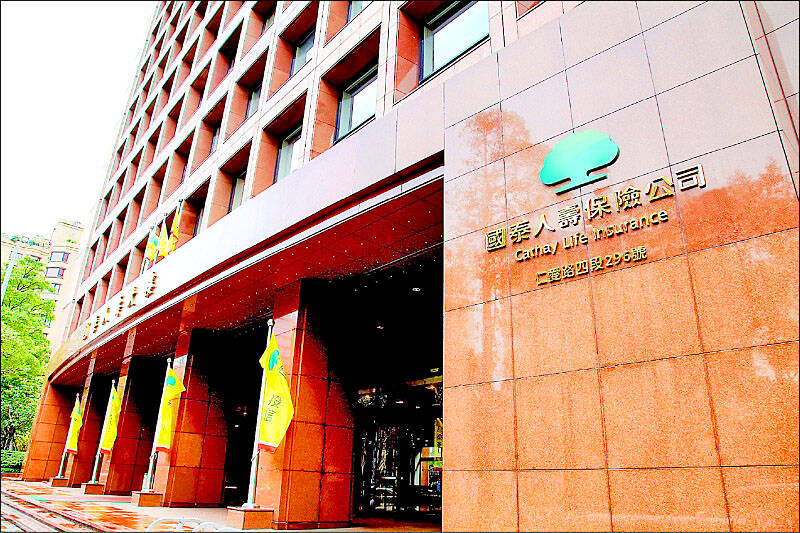A surge in insurance sales in Taiwan is threatening to spur an increase in capital outflows, potentially dragging the New Taiwan dollar to levels seen during the global financial crisis.
Sales of insurance policies in Taiwan rose to more than NT$100 billion (US$3.05 billion) in December last year, the highest for a month since January 2022, Taiwan’s Insurance Institute data released last week showed.
The demand was mainly driven by better returns on the products compared with banks’ foreign-currency deposits.

Photo courtesy of Cathay Life Insurance Co
Analysts are concerned that Taiwan’s NT$1 trillion life insurance industry, which has been piling into overseas assets due to the lack of high-yielding fixed-income instruments at home, will accelerate those investments.
Such a move would result in heavy capital outflows and weigh on the NT dollar.
“With more policies being sold, there will also be more investment from Taiwanese lifers in dollar-denominated products, such as US bonds and dividend stocks, as these offer quite competitive yields compared to local and regional fixed income products,” said Lynn Song (宋林), an economist at ING Bank NV.
“In a vacuum, it is another factor adding to Taiwan dollar depreciation pressure over the medium term,” Song said.
The NT dollar is already weakening due to the threat of a global trade war and the nation’s large interest-rate discount to the US.
Earlier this year, the currency fell below the key psychological level of US$33 for the first time in nine years and has trailed behind most of its North Asian peers in performance so far this year.
“We see it testing the bottom of 34-35 versus the dollar this year, at least,” said Stephen Chiu (趙志軒), chief Asian foreign-exchange and rates strategist at Bloomberg Intelligence.
Those are levels seen during the global financial crisis in 2009. A weaker currency is favorable for Taiwan’s export-oriented economy, but the central bank intervened this month to stabilize the market.
President William Lai (賴清德) also vowed to keep forex, the interest rate and inflation stable amid rising geopolitical tensions.
The NT dollar is losing another pillar of support. Local insurers typically short the greenback against the NT dollar in the non-deliverable forwards market to hedge against a stronger local currency.
Expectations for Taiwan’s currency to eventually weaken closer to US$34 is limiting insurers’ hedging activity, said Ju Wang (王菊), head of regional foreign-exchange and rates strategy at BNP Paribas in Hong Kong.

Three experts in the high technology industry have said that US President Donald Trump’s pledge to impose higher tariffs on Taiwanese semiconductors is part of an effort to force Taiwan Semiconductor Manufacturing Co (TSMC, 台積電) to the negotiating table. In a speech to Republicans on Jan. 27, Trump said he intends to impose tariffs on Taiwan to bring chip production to the US. “The incentive is going to be they’re not going to want to pay a 25, 50 or even a 100 percent tax,” he said. Darson Chiu (邱達生), an economics professor at Taichung-based Tunghai University and director-general of

‘LEGACY CHIPS’: Chinese companies have dramatically increased mature chip production capacity, but the West’s drive for secure supply chains offers a lifeline for Taiwan When Powerchip Technology Corp (力晶科技) entered a deal with the eastern Chinese city of Hefei in 2015 to set up a new chip foundry, it hoped the move would help provide better access to the promising Chinese market. However, nine years later, that Chinese foundry, Nexchip Semiconductor Corp (合晶集成), has become one of its biggest rivals in the legacy chip space, leveraging steep discounts after Beijing’s localization call forced Powerchip to give up the once-lucrative business making integrated circuits for Chinese flat panels. Nexchip is among Chinese foundries quickly winning market share in the crucial US$56.3 billion industry of so-called legacy

Taiwan Semiconductor Manufacturing Co (TSMC, 台積電) yesterday held its first board of directors meeting in the US, at which it did not unveil any new US investments despite mounting tariff threats from US President Donald Trump. Trump has threatened to impose 100 percent tariffs on Taiwan-made chips, prompting market speculation that TSMC might consider boosting its chip capacity in the US or ramping up production of advanced chips such as those using a 2-nanometer technology process at its Arizona fabs ahead of schedule. Speculation also swirled that the chipmaker might consider building its own advanced packaging capacity in the US as part

A move by US President Donald Trump to slap a 25 percent tariff on all steel imports is expected to place Taiwan-made steel, which already has a 25 percent tariff, on an equal footing, the Taiwan Steel & Iron Industries Association said yesterday. Speaking with CNA, association chairman Hwang Chien-chih (黃建智) said such an equal footing is expected to boost Taiwan’s competitive edge against other countries in the US market, describing the tariffs as "positive" for Taiwanese steel exporters. On Monday, Trump signed two executive orders imposing the new metal tariffs on imported steel and aluminum with no exceptions and exemptions, effective